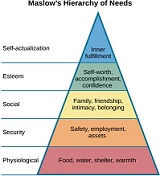Critical Review of Theories of Staff Turnover Intentions and their Implications to Staff Turnover in National Non-governmental Organizations in South Sudan

Abstract:
An employee
remains to be one of the most valuable resources of an organization. Unfortunately,
high turnover rate in the national non-governmental organizations in South Sudan
continues to be a concern for them and various stakeholders. This is because organizations
spend a lot of resources in training and investing in their employees. The
purpose of the study was to review the various theories that explain staff turnover
with the aim of understanding their distinct views. The methodology involved the
review of literature of turnover theories and models. The researcher was able to
find six theories that helped to explain the phenomenon of staff turnover, and each
provided distinct factors that when not addressed could lead to staff turnover.
Maslow’s hierarchy of needs which identified different human needs which if not
met could lead to staff turnover. Herzberg’s motivation-hygiene
theory revealed two factors that need to be addressed by an organization,
namely, “motivation factors” and “hygiene factors”. The Social Exchange Theory explains
that turnover intentions come because of non-compliance with the agreed rules by
either the management or the staff. LMX Theory emphasized the importance of
maintaining good relationships between leaders
and members in different groups to promote better performance at work and minimize
staff turnover.
References:
[1] Laura M.
(2023). Employee Retention Strategies for Nonprofits: Complete Guide. Graham-Pelton.
Retrieved from https://grahampelton.com/insights/nonprofit-employee-retention/.
[2] Brew, A.
(2020). Breaking news: 23% of pulse survey respondents indicate disinterest in working
for nonprofits. Non-profit HR. Retrieved from https://www.nonprofithr.com/.
[3] Armstrong
M. (2001). A handbook of Human Resource Management and Practice, 8 th Edition. Bath
Press Ltd.
[4] Knight DK,
Becan JE, Flynn PM. (2013). The Impact of Staff Turnover on Workplace Demands and
Coworker Relationships. Counselor (Deerfield Beach). 14(3):20-23. PMID: 27540331;
PMCID: PMC4986917.
[5] Sally C.
S & Jessica E. S. (2015) Voluntary Turnover in Nonprofit Human Service Organizations:
The Impact of High-Performance Work Practices, Human Service Organizations: Management,
Leadership & Governance, 39:3, 182-207, DOI: 10.1080/23303131.2015.1031416.
[6] Allen D.G.,
Bryant P.C., Vardaman J.M. (2010). Retaining talent: replacing misconceptions with
evidence-based strategies. Acad. Manag. Perspect. 24(2):48–64.
[7] Maslow,
A. H. (1954a). Motivation and Personality. New York: Harper.
[8] Dar, Showkat
& P.sakthivel, Prof. (2022). Maslow’s Hierarchy of Needs Is still Relevant in
the 21st Century. 02. 1-9. 10.55529/jlep.23.1.9.
[9] Herzberg,
F. I., Mausner, B., & Snyderman, B. (1959). The motivation to work (2nd ed.).
New York: John Wiley.
[10] Dartey.
B. K. & Amoako G. (2011). Application of Frederick Herzberg’s
Two-Factor theory in assessing and understanding employee motivation at work: A
Ghanaian Perspective. European Journal of Business & Management. 3(9).
[11] Nanayakkara,
M.K.N.P. and Dayarathna, N.W.K.D.K. (2016). Application of Herzberg’s
Two Factor Theory of Motivation to Identify Turnover Intention of the Non-Executive
Level Employees in Selected Super Markets in Colombo, Sri Lanka. Human Resource
Management Journal. 4(1). 27 -33.
[12] Merin A.
(2021). Employee Retention Theories – Analysis & Implementation. Retrieved at
https://hrshelf.com/employee-retention_theories/#1_The_Theory_of_Organisational_Equilibrium_TOE.
[13] Mitchell,
T. R., Holtom, B. c., Lee, T. W., Sablynski, C. 1., & Erez, M. (2001). Why people
stay: Using job embeddedness to predict voluntary turnover. The Academy of Management
Journal, 44, 1102-1121.
[14] Cynthia D.O. (2018).
Relationship Between Job Embeddedness and Turnover Intention of High School Math
Teachers. Doctoral thesis; Walden University. Retrieved from https://scholarworks.waldenu.edu/cgi/viewcontent.cgi?article=7366&context=dissertations.
[15] Nelson,
T. A. (2013). Leader-Member Exchange Theory: Examining the Dynamics and Potential
Contributions of the Middle-Quality Group. S.l.: University of Memphis.
[16] Hitesh B.
(2023). Leader-Member Exchange Theory (LMX Theory) Explained, Accessed at https://www.marketing91.com/leader-member-exchange-theory/.
[17] Illies,
R., Nahrgang, J. D., & Morgeson, F. P. (2007). Leader-member exchange and citizenship
behaviors: A meta-analysis. Journal of Applied Psychology, 92(1): 269–277.
[18] Dulebohn.
J. H., Wu, D., & Liao, C. (2017). Does liking explain variance above and beyond
LMX? Human Resource Management Review, 27(1): 149–166.
[19] Homans,
George C. (1958), “Social Behaviour as Exchange.” American Journal of Sociology
63, 6: 597-606
[20] Kendra C.
(2023). Understanding Social Exchange Theory in Psychology. Retrieved from https://www.verywellmind.com/what-is-social-exchange-theory-2795882#citation-1.
[21] Redmond, Mark V. (2015). Social Exchange Theory.
English Technical Reports and White Papers. 5. http://lib.dr.iastate.edu/engl_reports/5.
[22] Shraddha B. (2018). Social Exchange Theory in Businesstopia,
retrieved at https://www.businesstopia.net/communication/social-exchange-theory.
[23] Homans, George C. (1958), “Social Behaviour as
Exchange.” American Journal of Sociology 63, 6: 597-606.
[24] Kate B. (2021). Understanding Social Exchange Theory
in Relationships. Psycho Central. Retrieved from https://psychcentral.com/health/social-exchange-theory.
[25] Homans, G. C. (1961). Social behavior: Its elementary
forms. Harcourt, Brace.
[26] Stone, B. (2023, January 20). The Application of
Social Exchange Theory by Entrepreneurs Leading Small Businesses in Appalachia.
https://doi.org/10.31219/osf.io/mvz8t.
[27] King M.
A. (1981). An Application of Social Exchange Theory to Social Work Administration.
Dissertation Abstracts International, (42)9, page: 4152.

